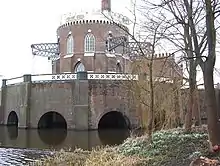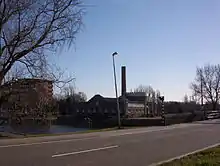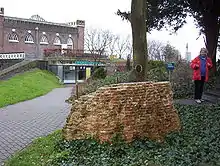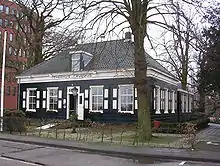



The Museum De Cruquius (or Cruquiusmuseum) occupies the old Cruquius steam pumping station in Cruquius, the Netherlands. It derives its name from Nicolaas Kruik (1678–1754), a Dutch land-surveyor and one of many promoters of a plan to pump the Haarlemmermeer (Haarlem lake) dry. Like many well-educated men of his time, he latinized his name to Nicolaus Samuel Cruquius. During his lifetime the issue of the Haarlem Lake and how to pump it dry was international news, as the following excerpt from the Virginia Gazette on 31 May 1751 illustrates:
- "By a private letter from Rotterdam, we are told, that the Dutch Engineers, in their Plan for draining the lake of Haerlem, proposed to employ 150 mills for three Years, and had computed the Expence at a Million and Half of Florins, but that a German, who had been long employed in the Mines of Hungary and Hartz, had proposed to drain it with 50 machines, in 15 months, at a far less Expence; and that he has been ordered to erect one of those Machines, which, if it shall be found to execute what he has asserted, his Proposal will be immediately accepted."
Even 50 machines proved too expensive, so it was not until successful experiments with steam pumping stations, such as at nearby Groenendaal park in 1781, that serious plans resulted in three steam-driven pumping stations, including the one at Cruquius. As a tribute to former planners, the pumping stations of the Haarlemmermeer were named after them. The one at the mouth of the Spaarne river, near Heemstede, was called Cruquius. To service the mill, the workers who lived there founded the town of the same name. The dike was built in the 1840s, the pump started work in 1850 and in the three years that had been predicted a century before, the Haarlem lake was pumped dry. The pumping station Cruquius continued to work on and off until 1933, when it was made into a museum. The foreman's house was made into a café which it still is today.
Heritage site
The pump house at Cruquius is a Netherlands 'Rijksmonument' for the historical engine. It has also been declared an Anchor Point of ERIH, The European Route of Industrial Heritage.[1] It is thought to be the largest steam engine – and certainly the largest beam engine – ever built. The engine was built by Harvey & Co, of Hayle, Cornwall. The diameter of the piston is 144 inches (3.7 m).[2]
Outside, the ringvaart canal's system of sluices, mills, and bridges, are all part of the Stelling van Amsterdam, the main dike of which runs just north of Cruquius, through Vijfhuizen. Fort Vijfhuizen is used for art exhibitions and is a short walk north of the museum along the ringvaart. What is less known is that there is also a fort Cruquius, just south of the museum, that also has World Heritage status because of its link to the Stelling van Amsterdam.
The Cruquius Pumping Station was named a Historic Mechanical Engineering Landmark by the American Society of Mechanical Engineers in 1991.[3][4]
References
- ↑ "ERIH Entry: Steam Pumping Station De Cruquius". European Route of Industrial Heritage. 2014. Retrieved 15 January 2015.
- ↑ Gisolf, Robert J H (2009) [1999]. "Cruquius Monument". Archived from the original on 2012-02-06. Retrieved 2009-06-03.
- ↑ "Cruquius Pumping Station (1849)". Landmarks. American Society of Mechanical Engineers. Retrieved 2009-01-18.
- ↑ "Haarlemmermeer Cruquius" (PDF). Haarlemmermeer Cruquius brochure. ASME. Archived from the original (PDF) on 2011-07-25. Retrieved 2009-01-18.
External links
Cruquius Pumping Station.
- Museum De Cruquius (in English) – official website
- Original Cruquius website – includes comprehensive details of the steam engine's design, operation and restoration; video clips of the engine in action; 3D computer simulations of the mechanism operating; photos, technical drawings, and more.